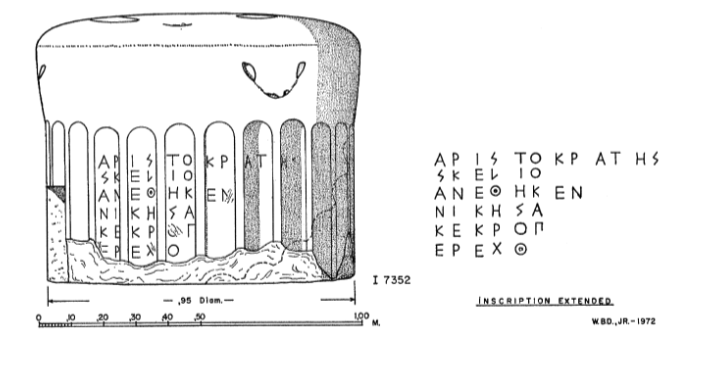[Lemma] Athens, in a basement of Odos Poikilis. The artifact was found during some construction works carried out in 1970. Previously (1835) the artifact had been sighted near the gate of Minerva Archegetis in the Roman Agora of Athens (see Pittakys 1835; IG I2, 772).
Ionic column drum in Pentelic marble, with 24 grooves ending well below the top. Height 0.85 m; shaft diameter 0.95 m. The crowning element has a slightly larger diameter and is decorated with ornaments in the shape of eggs or leaves, positioned so that they are under the feet of a tripod. The upper part of the shaft and the top are heavily worn due to the reuse of the artifact as a millstone.
Light blue alphabet, which, however, has elements of the Ionic type, dark blue. The letters, in some cases no longer clearly visible but nonetheless recognizable (thanks in part to comparison with a meritorious apograph made by Pittakys), are accurately engraved. The inscription has a progressive course and is arranged in six lines of writing, drawn horizontally, thus perpendicular to the grooves, each bearing two letters. The height of the graphemes ranges between 0.3 and 0.34 cm.
To be noted: alpha with horizontal inner stroke; epsilon with horizontal parallel strokes; eta for the long closed vowel /e/, with slightly curved vertical strokes; theta with inner dot; chalcidian lambda; ni with outer strokes of equal length; hooked pi; rho with round eyelet; three-stroke sigma.
[Typology]
[Period] 450–400 BC, on a paleographic basis (not before 420 BC, according to Shear, based on historical considerations).
[Text]
Ἀριστοκράτης
Σκελίō
ἀνέθηκ<ε>ν
νικήσα[ς]
Κεκροπ[ίδι] 5
Ἐρεχθ̣[ηίδι]
— — —
[Critical apparatus]
[Translation]
Aristokrates
son of Skelias
dedicated
having won
with the Kekropis 5
and Erechtheis tribes
[Comment]
The inscription was first brought to light by Pittakys, who had the opportunity to see it in the western part of the gate of Athena Archegetis, in the Athenian Agora. The document was reported in IG II2, 772. However, since then, it was not studied again until 1970, when it was ‘rediscovered’, so to speak, by Shear, about fifty meters from the place where Pittakys found it. A new edition followed in 1973.
The column was likely erected in the Pytion, like many other monuments of this kind. It is possible (Shear) that Plato refers to our inscription in a passage of his Gorgias (472a).
The document clearly attests to a transitional alphabetic phase in Athens, from the ‘light blue’ to the ‘dark blue’ one, already used before the Euclidean reform of 403/2. The spelling of the patronymic, with only one lambda, which might seem unusual (Lewis) compared to the well-attested form Σκελλίας (LGPN II, s.v.), could be explained (Shear) as a conscious archaism by the stonecutter.
As mentioned before, the text is engraved in six of the twenty-four grooves of a monumental stone shaft, with two letters per groove, resulting in an alignment that is not only horizontal but also vertical (stoichedic), as you can see from the image. The writing surface becomes increasingly worn as one moves from left to right and from top to bottom. There was only one word per line. We cannot be certain that the inscription is complete at the bottom, where the nature of the competition — between men or boys — and the name of the didaskalos could have been specified.
The structure of the dedication is thus: name of the choregos, patronymic, dedication verb, indication of the victory, name of a tribe (the one paying the choregos), name of a second tribe (the two were paired by lot). The mention of two tribes suggests that the dedication commemorated a victory at the Thargelia.
Aristokrates, the choregos (not explicitly identified as such), appears as the dedicant (anetheken). The fact that all known activities of this prestigious figure (see Davies 1971, 56-59, no. 1904) are dated to the last quarter of the 5th century BC led Shear to date the document (and the choregic victory it refers to) later than 420 BC. Lewis’s attempt to attribute the document to the archaic age seems unconvincing (Lewis 1964).
[Documentation] It is here reproduced the drawing in AMADRY 1977, 187, fig. 8.

[Reference edition]
IERANÒ 1997, 353, nr. 65.
[Essential bibliography]
IG I3 964; K. S. PITTAKYS, L’ancienne Athénes, Athens 1835; A. E. RAUBITSCHEK, Dedications on the Athenian Akropolis, Cambridge, Mass. 1949; H. MATTINGLY, Historia 10, 1961, 149-150; B. D. MERITT – H. T. WADE-GERY, ‘The Dating of Documents to the Mid-Fifth Century – II’, JHS 83, 1963, 100-117; D. M. LEWIS, ‘The Dedication of Aristokrates’, JHS 84, 1964, 156-157; J. K. DAVIES, Athenian Propertied Families. 600-300 BC, Oxford 1971; T. L. Jr. SHEAR, ‘The Athenian Agora: Excavations of 1971’, Hesperia 42/2, 1973, 121-179; P. AMANDRY, ‘Trépieds d’Athènes, I, Dionysies’, BCH 100, 1976, 15-93; P. AMANDRY, ‘Trépieds d’Athènes: II. Thargélies’, BCH 101/1, 1977, 165-202; J. P. BARRON, ‘The Fifth-Century Horoi of Aigina’, JHS 103, 1983, 1-12; G. IERANÒ, Il ditirambo di Dioniso. Le testimonianze antiche, Pisa-Roma 1997; P. WILSON, The Athenian Institution of the Khoregia: The Chorus, the City and the Stage, Cambridge – New York 2000.
[Keywords]
Athens, Thargelia, choregic dedications, votive column, ‘light blue’ Athenian alphabet, Aristokrates, Skelia, Kekropis tribe, Erechtheis tribe
[Giovanni Boffa]







